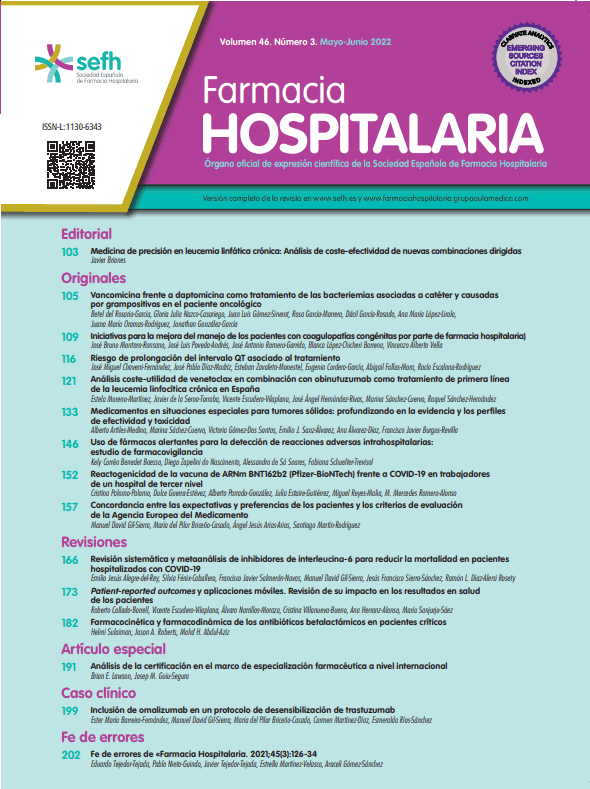To develop a system of data management that allows us to estimate the comparative effectiveness of the various antiretroviral treatment (ART) regimens.
MethodRestrospective observational study in patients infected with HIV with stable ART. Adherence to treatment and unit cost for each patient's treatment was determined. The cost/ patient/day was calculated and, multiplying by an adherence factor (fADH), the (cost/patient/day)ADH. The comparison of both allowed us to obtain the Δcost/patient, which estimates the additional costs caused by lack of adherence. The incremental cost-effectiveness (iCER), grouping the results by the various coformulated drugs (“combos”). A study of the budgetary impact of these combos was carried out.
Results468 patients were evaluated (62% adherent). Average adherence was 88±18%. The average value of (cost/patient/day)ADH was significantly higher than the cost/patient/day (27.3±9.8 € compared to 24.3±7.6 €, P<.001). Just as with the fADH, no differences were found in the Δcost/patient between the different ART combinations. The combo with the least deviation from the cost/patient/day due to lack of adherence was that composed of abacavir/zedovudine/lamivudine (ABC/AZT/3TC,Δcost/patient=8.72±14.18%), and that with the greatest deviation AZT/3TC (Δcost/patient=13.52±17.68%). No significant differences were found in the iCER calcluated for any combo. The ART that included abacavir/lamivudine (ABC/3TC) obtained the least budgetary impact.
ConclusionsThe greatest cost and percentage of adherent patients associated with the combos composed of Tenovovir/Emtricitabine(TDF/FTC) and ABC/3TC, and the least cost and effectiveness of those composed of AZT/3TC and ABC/AZT/3TC, does not allow us to identify any option as significantly dominant. The regimens with ABC/3TC were shown to be the most favourable from the combined point of view of cost and adherence.
Desarrollar una sistemática de manejo de datos que permita estimar comparativamente la eficiencia de los diferentes esquemas de tratamiento antirretroviral (TAR).
Método: Estudio observacional retrospectivo en pacientes infectados por el VIH con TAR estable. Se determinó para cada paciente su adherencia y el coste unitario de su tratamiento. Se calculó el coste/paciente/día y, multiplicando por un factor de adherencia (fADH), el (coste/paciente/día)ADH. La comparación de ambos permitió obtener el Δcoste/paciente, que estima la desviación de costes originada por la falta de adherencia. Se calculó el coste-efectividad-incremental (CEI) agrupando los resultados en los diferentes fármacos coformulados (combos). Se realizó un estudio de impacto presupuestario de dichos combos.
ResultadosSe evaluaron 468 pacientes (62% adherentes). La adherencia media fue de 88 ± 18%. El valor medio del (coste/paciente/día)ADH fue significativamente superior al coste/paciente/día (27,3 ± 9,8 € frente 24,3 ± 7,6 €, p < 0,001). Al igual que para el fADH, no se encontraron diferencias en el Δcoste/paciente entre las diferentes combinaciones de TAR. El combo con menor desviación del coste/paciente/día debida a la falta de adherencia fue el constituido por abacavir/zidovudina/lamivudina (ABC/AZT/3TC,Δcoste/paciente=8,72±14,18%), y el de mayor desviación el AZT/3TC (Δcoste/paciente=13,52±17,68%). No se encontraron diferencias significativas en los CEI calculados para ningún combo. Los esquemas de TAR que incluyeron abacavir/lamivudina(ABC/3TC) obtuvieron el menor impacto presupuestario.
ConclusionesEl mayor coste y porcentaje de pacientes adherentes asociados a los combos compuestos por tenofovir/emtricitabina (TDF/FTC) y ABC/3TC, y el menor coste y efectividad de los compuestos por AZT/3TC y ABC/AZT/3TC no permiten identificar ninguna opción significativamente dominante. Los esquemas con ABC/3TC se muestran como los más favorables desde el punto de vista combinado del coste y la adherencia.






